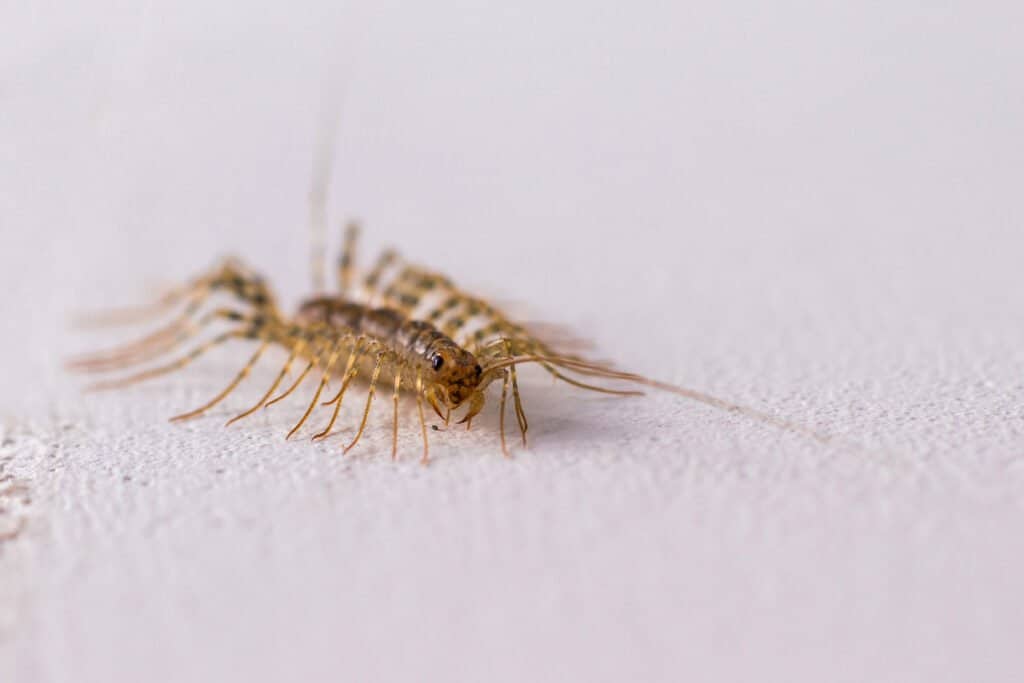Table Of Content

The pests lurk in dark, hidden areas and may bite people or pets if they appear to pose a threat. House centipedes are common pests found in homes, especially in damp and dark areas. They primarily reside in outdoor habitats like gardens and basements but can enter homes during hot or dry conditions outdoors. Remember, attempting to deal with centipede infestations on your own can be challenging and may not yield satisfactory results. By consulting a pest control expert, you can ensure that the infestation is properly addressed, giving you peace of mind and a centipede-free living environment.
More in Pests
Cortisone cream and antihistamines can also reduce symptoms of allergies. Researchers have isolated more than 500 components of centipede venom, but they have only described a few of these. The bite looks like two red marks on the skin, which form a V-shape due to the positioning of the forcipules of the centipede. To avoid infection, use a topical antibiotic and keep the site clean and covered.
Why do I have centipedes in my house?
There have also been several other undocumented reports of centipede-related human deaths. But even so, it appears safe to say that even the worst centipede pinch won’t kill you. It’s, however, also safe to say that a giant centipede bite can be excruciatingly painful, based on numerous reports. For a mild to moderate centipede envenomation, you can expect pain and swelling. The wound area may itch and burn, and the skin around it may be tender, but this discomfort should go away within 24 to 48 hours. However, if the swelling begins moving upward or you start seeing signs of infection, consult a doctor immediately.
What should you do if you’ve been bitten by a centipede?
The pain is often compared to a bee sting, accompanied by redness and swelling. Because house centipedes prefer warm and wet environments, they’re frequently found in the Southern states. However, you’ll also find them in Northern basements, taking shelter from the cold outside. In some situations, underlying diseases may affect the outlook of a person with a centipede bite. For example, people with diabetes may experience more severe skin reactions and infections following a centipede bite.
What Do House Centipedes Eat?
The centipede’s unique venomous front legs evolved over 430 million years ago. Centipedes are the only animals with forcipules, which contain venom glands. Their front legs form sharp pincers just behind their head, and they use it to inject venom and hold their captured prey. A centipede’s body is typically yellowish to dark brown in color, with occasionally deeper stripes or patterns.
Venomous centipede with bite like bee sting spotted in Nottinghamshire for first time - Nottinghamshire Live
Venomous centipede with bite like bee sting spotted in Nottinghamshire for first time.
Posted: Mon, 22 Jan 2024 08:00:00 GMT [source]
Still, house centipedes are basically harmless to humans, and they're effective predators of other insect nuisances, including roaches, flies, silverfish, and termites. So, if you can learn to not be terrified of them, you should let them do their thing. If you’re like most people, you’ll be able to care for a centipede bite at home, and you won’t have to get a medical professional involved. But if you have a health condition that calls for you to be cautious, an infected bite, or an allergic reaction, you should continue to closely monitor the bite. You may also want to have small children with centipede bites looked at by a doctor.
If this does occur, always head to your local GP for further advice. Even in the rare cases that this insect bites with enough force to pierce through the skin, the venom only feels like a pinch. Researchers do not consider centipedes poisonous since there is little to no registered evidence that would show that the bite of these insects can be fatal. At the same time, it must be kept in mind that house centipedes do not have claws that are capable of piercing through human skin.
Places You Never Knew Pests Were Hiding
While house centipedes can inflict a bite, it is of minor consequence and it rarely does so. When given the chance, house centipedes prefer to quickly retreat from danger rather than bite. If you do not have any other insects in your home, they will not stay there for long.
These creatures are more inclined to avoid humans and are generally harmless. Understanding their behavior and taking precautions to reduce encounters with them is often the best approach to coexisting with house centipedes in your home. House centipedes are typically yellowish-gray with elongated, flattened bodies and numerous legs. They are often found in homes, especially in damp areas like basements, bathrooms, and crawl spaces. While they can be startling due to their appearance and rapid movements, they are not venomous or harmful to humans. House centipedes can look scary, but they’re not harmful and are not likely to bite humans.

A bite from a house centipede is generally not a cause for major concern. Following the steps outlined above can help manage any discomfort and minimize the risk of infection. Remember that prevention is key, so taking measures to reduce the presence of house centipedes in your home can significantly lower the chances of getting bitten in the first place.
Centipedes: They bite, but don't kill them. Here's why - Yahoo News Canada
Centipedes: They bite, but don't kill them. Here's why.
Posted: Fri, 14 Apr 2023 07:00:00 GMT [source]
However, they are so small that the bite is not likely to break through a person’s skin. House centipedes typically do not try to bite humans because they don’t see humans as a food source. As long as you don’t touch it, the centipede is not likely to attack you or try to bite you. If someone is experiencing anaphylactic shock, epinephrine auto-injectors, such as an EpiPen, can reduce the symptoms and prevent death. As centipede bites are uncommon, though, a person may not know that they are allergic to centipede venom until they receive a bite.
However, there have been sporadic reports of heart attacks, blood in the urine, rhabdomyolysis, or excessive bleeding. Additionally, centipedes can be as small as 1 inch long or as large as 7 inches. There might be as few as 15 pairs of legs on a centipede or as many as 177. On the other hand, the giant desert centipede (Scolopendra heros) found in the Southwest, is a very large centipede that can reach 8 – 10 inches in length. They are somewhat aggressive and will readily bite a perceived threat.
Thankfully, house centipede bites aren’t too much of a problem in terms of pain. Once your house has been cleansed of all pests and insects, you may also stop living in constant fear of a centipede bite, as these creatures are most likely to leave. While house centipedes will not bite humans to feed, centipedes may use their poison claws if they suspect humans of being a threat. One of the most pertinent reasons why centipedes may have been making their way into your house is that there are some pests in the house which you haven't taken care of in a while. While it is unlikely that this creature would have any interest in you and your life, centipede bites can be quite intimidating.
When an insect is venomous, it means that it has the ability to deposit toxins into the bloodstream. Whether it’s used for hunting or self-defense, the insect will use the venom intentionally. Think of the house centipede using its venom-filled legs to subdue prey. The toxins are responsible for the inflammation and mild burning sensation we discussed earlier. Once again, those who are more sensitive to insect allergens might experience more irritation than most.

No comments:
Post a Comment